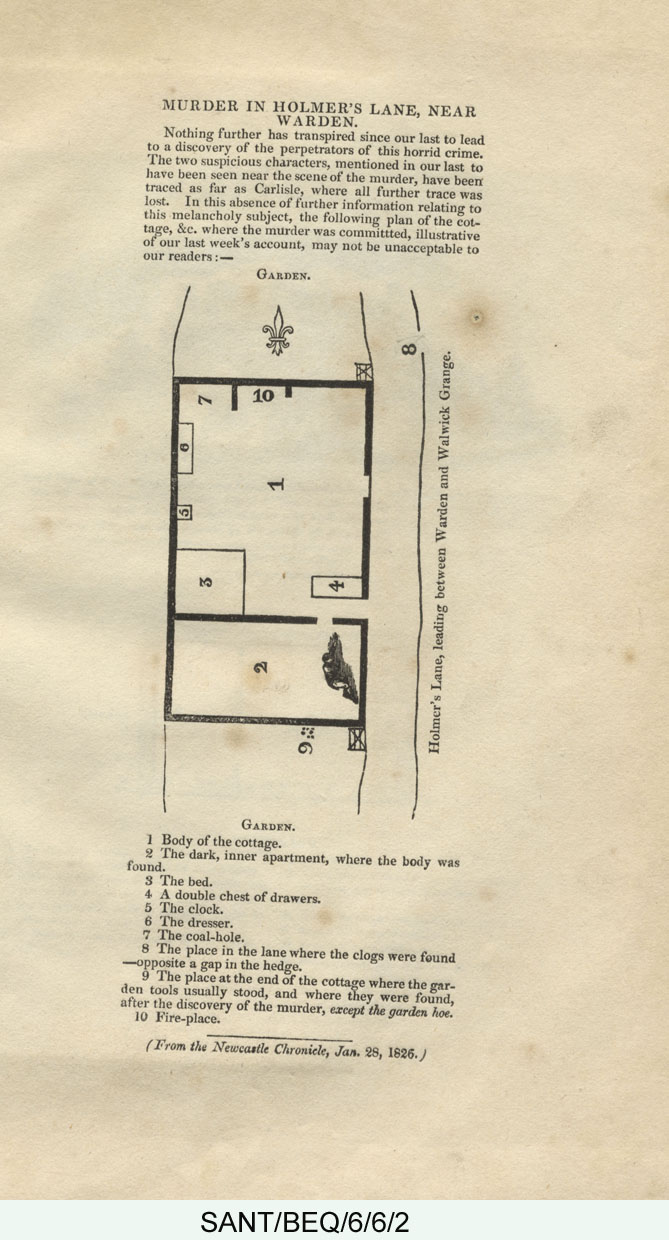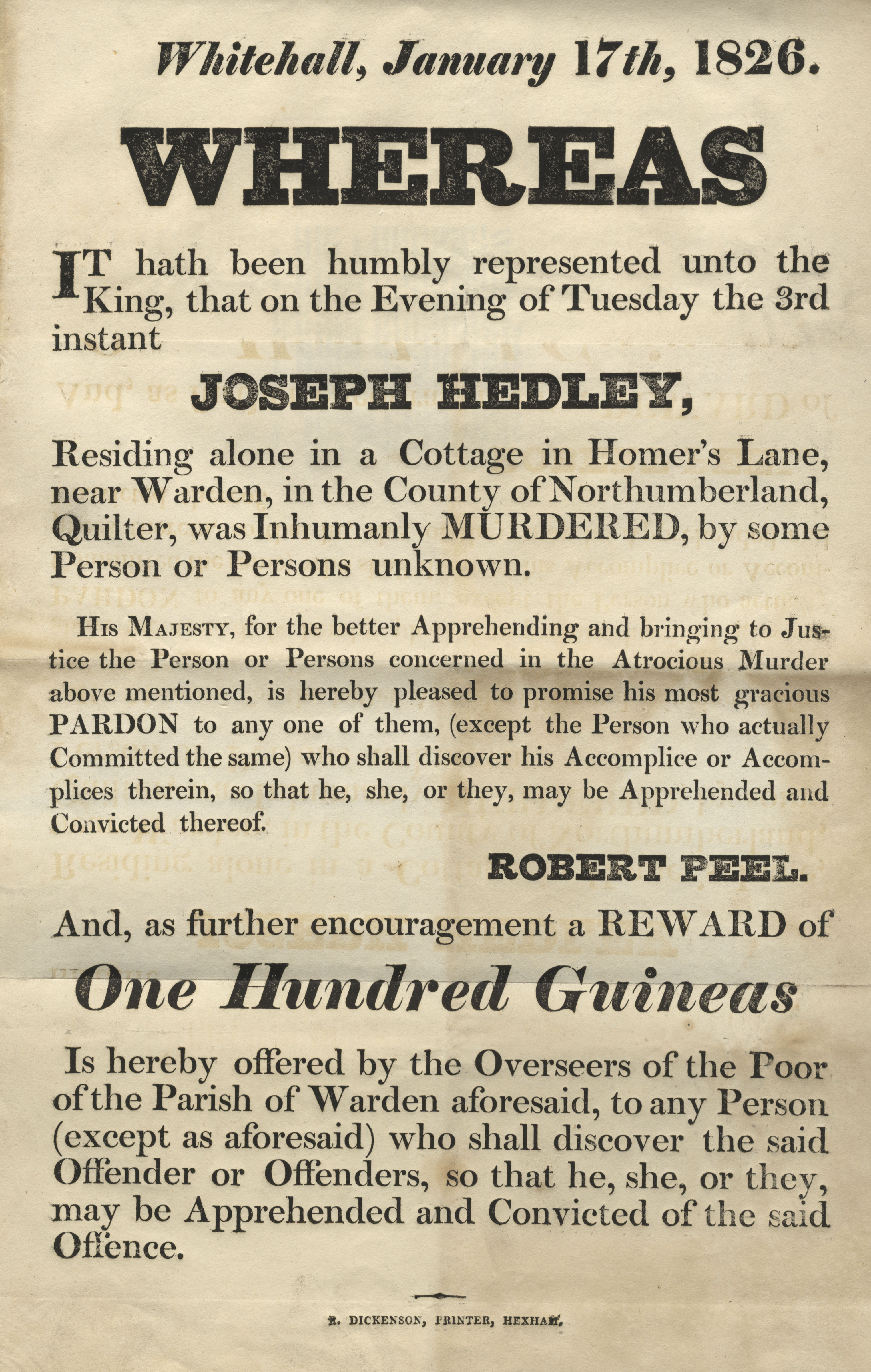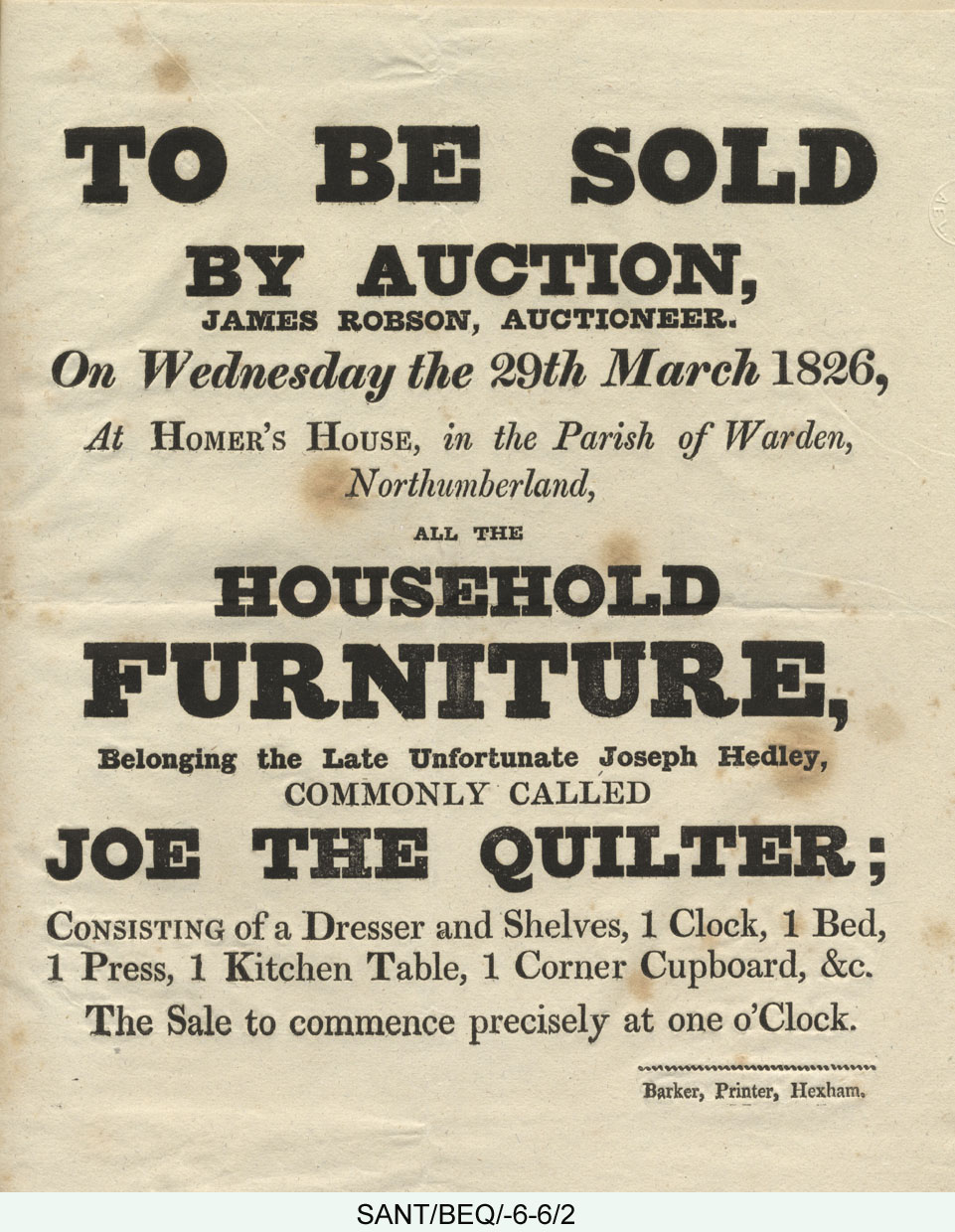On 3 January 1826 a 76 year old man named Joseph Hedley was brutally murdered in his cottage in the parish of Warden. Joseph’s throat and face were slashed and multiple stab wounds were inflicted upon his body. He was commonly known as Joe the Quilter due to his skill with needlework. He was a quilter by trade and travelled around the country seeking employment. Joe’s skills in quilting were celebrated, and his handiwork was known in various parts of England, Ireland, Scotland and America.
On the evening of the murder, Joe obtained a pitcher of milk, a pound of sugar, a sheep’s head and pluck (offal) from farmer’s wife Mrs Colbeck of Warwick Grange. At approximately 6pm William Herdman, a labourer living in Wall called in on Joe on his way home from work at the local paper mill and sat with him for a short time. Joe had a good fire going and was busy preparing some potatoes for his supper. Around 7pm Mrs Biggs, a female pedlar from Stamfordham knocked at the cottage to ask directions to Fourstones having missed the turning due to the excessive darkness of the night. Joe came to the door and gave her the necessary directions. Apart from the murderer(s), Mrs Biggs is said to be the last person to have seen him alive.

At approximately 8pm a Mr Smith of Haughton Castle rode past the cottage on his way home from Warden and all at the cottage was silent and dark. It is suspected that the deed took place between 7-8pm. Concern for Joe’s safety grew after his neighbours didn’t see the elderly man for a few days. It was reported that there appeared to be marks of blood in the snow outside the cottage and marks to indicate that a struggle had taken place. His neighbours found the cottage door locked and after knocking several times with no reply proceeded to break into the property. They were faced with a chilling sight as parts of the walls of the cottage were stained with blood and a quilt spread on a frame bore a distinct mark of a bloody handprint. The pitcher of milk, sheep’s head and pound of sugar which he had recently purchased were found lying on a table. A search of the house was conducted and nothing was found. An old outhouse which stored wood and coals was then searched and Joe’s body was discovered. Both cheeks were cut widely open with deep wounds. A garden hoe was found laid across his chest. A coal rake was also found with its shank bent. As two weapons were discovered it then raised a suspicion that there were 2 murderers. Joe was found with knife wounds on his hands so had obviously fought with the attacker(s).
The small cottage had been ransacked and bore evidence of a struggle. All of his boxes and drawers had been disturbed and it was believed that two silver tablespoons, four teaspoons and two old fashioned salt cellars of silver net-work had been stolen.The bed tester had been violently torn down and the face of the clock broken. Prints of 3 bloody fingers were distinctly visible on the chimney jamb . The plates on the dresser were also streaked with blood. Outside in the lane some clogs were found and a small piece of coat was discovered on a hedge.It was supposed that Joe had fought hard with the murderer(s) and had managed to escape about 100 yards from the cottage before he was caught. Judging by the marks in the snow it appeared that a struggle had taken place and then Joe had been overcome and dragged back and murdered. After this had taken place the cottage door had been locked on the outside and the key taken away.

A one hundred guineas reward was offered to catch the perpetrator(s) of the atrocious murder . The reward was offered from the Overseers of the Poor of the parish of Warden on 17 January 1826. Home secretary Robert Peel offered his majesty’s full pardon to any accomplices who came forward with information (as long as they were not the actual murderer). A jury returned a verdict of wilful murder against some person or persons unknown. Although several people were arrested and questioned nobody was ever charged and sadly the murder of Joe the Quilter was never solved. Joe was buried in Warden churchyard on 10 January 1826. On his burial entry the word murdered can clearly be read underneath his name.
On Wednesday 29 March 1826, an auction was held to sell the household furniture belonging to the ‘late unfortunate Joseph Hedley, commonly called Joe The Quilter’.



Did anyone attend his funeral?
We had a real in depth discussion with a gentleman at Joe’s cottage I Beamish museum.
Why was such a large reward offered?
This question keeps coming to mind, if Joe was such a lonely poor man, why would anyone want to post such a reward?
The reward was not uncommon for a murder of this nature. There is no mystery to it.
Very interesting,after a visit to beamish museum
Weve just visited joe”s cottage at beamish , the chap was very informative , is it possible to find out Joe’s family tree ?
As im a Hedley and my family originate from Northumberland
Please email us at archives@northumberland.gov.uk and we can try to assist with your enquiry.
Me too! My Nanna was from Morpeth and was a Hedley. We are going to see if he was a relative
I too am a Hedley.
We to have links with Northumberland. My sister has carried out great work finding out stuff
I am too. My sister has done great work in finding our past. We wonder too whether he is part of our past
Unfortunately, the information regarding Joseph Hedley in the public domain at the moment is almost certainly incorrect, and I can say with equal certainty that he had no children. He may have had siblings but I could not find any information to that end through my research. However, there were other Hedleys who lived in that Parish, so he may have been connected to them. I’ve recently finished writing a book on Hedley’s murder and tried to reconstruct his life and world as best as I could manage with the available source material. Unfortunately, I have not yet found a publisher for the book, but when I do I will post it on my website http://www.hamsterwrangler.com. I hope that helps.
I wonder why the King got involved.. surely this would haver been unusual ?
It was not that unusual for a reward to be offered in the King’s name at that time, particularly for a heinous murder.
Interesting story but sad that an innocent man was murdered for what ? God bless his soul. I have just been to Beamish to visit the site of this cruel murder. Perhaps it is still possible in this age of DNA to solve this murder mystery !!!!
I’ve written a book on this that identifies who the murderer was most likely to have been, though I didn’t use DNA to identify that person. It is an interesting story, but unfortunately it was easier to identify the murderer than it has been to find a publisher, but hopefully that will happen soon and I will post it on my website – http://www.hamsterwrangler.com.
Whoever killed him must have thought that he was a wealthy man – stealing a few spoons was definitely not sufficient gain to have murdered poor Joseph. His quilts would have been interesting to see!
I would love to read your book if indeed you can get it published.
Such a sad story – would be interested to read your book too; hope you can get it published.
Terrible story and a pity no one was found guilty of the crime and I suspect we will never know for certain.
An isolated cottage in a remote place but on a roadway ,40 wounds on his face and neck and clear evidence of a fight and self defence could it have been a personal attack considering the clock face had been smashed.
The assumption that there was more than one murderer doesn’t ring true a single man physically strong could have overpowered Old Joe but two would have dominated him the reports of blood on the walls ETC and his defence wounds show that there was movement around the cottage in the attack plus Joe managed to get out and make a run for it.
In most cases involving more than one individual someone talks and remember a pardon was offered and the reward so it seems to me that there was only one individual, it could be argued that he was targeted from the evidence but he might simply have been a case of opening the door to the wrong person passing by.
Rest in peace Old Joe.
Thank you for your comment 😊
the cottage where the murder happend is rebuilt in Beamish museum
👍